Gait deviations Study guides, Class notes & Summaries
Looking for the best study guides, study notes and summaries about Gait deviations? On this page you'll find 208 study documents about Gait deviations.
Page 2 out of 208 results
Sort by
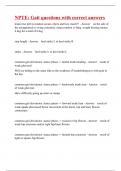
-
NPTE: Gait questions with correct answers
- Exam (elaborations) • 8 pages • 2023
- Available in package deal
-
- $11.49
- + learn more
transverse pelvis rotation occurs where and how much?? - Answer on the side of the unsupported or swing extremity. mean rotation is 4deg. weight bearing rotates 4 deg for a total of 8 deg step length - Answer heel strike L to heel strike R strike - Answer heel strike L to heel strike L common gait deviations: stance phase--> lateral trunk bending - Answer result of weak glut med Will see beding to the same side as the weakness (Trendelenburg) or with pain in the hip c...
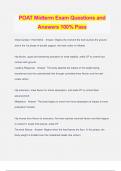
-
POAT Midterm Exam Questions and Answers 100% Pass
- Exam (elaborations) • 30 pages • 2024
-
- $12.49
- + learn more
POAT Midterm Exam Questions and Answers 100% Pass Initial Contact / Heel Strike - Answer- Begins the moment the foot touches the ground and is the 1st phase of double support, the heel rocker is initiated Hip flexion, quad and hamstring activation for knee stability, ankle DF to control foot contact with ground Loading Response - Answer- The body absorbs the impact of the weight being transferred onto the outstretched limb through controlled knee flexion and the heel rocker action Hip e...
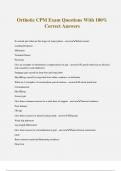
-
Orthotic CPM Exam Questions With 100% Correct Answers
- Exam (elaborations) • 15 pages • 2024
-
- $12.49
- + learn more
Orthotic CPM Exam Questions With 100% Correct Answers In normal gait what are the stages of stance phase - answerInitial contact Loading Response Midstance Terminal Stance Preswing Give an example of substitution (compensation) in gait - answerLateral trunk lean to affected side caused by weak abductors Steppage gait caused by drop foot and long limbs Hip Hiking caused by long limb from either weakness or deformity What are 4 examples of coronal plane gait deviations - answerLateral t...
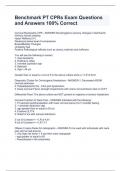
-
Benchmark PT CPRs Exam Questions and Answers 100% Correct
- Exam (elaborations) • 4 pages • 2024
- Available in package deal
-
- $10.99
- + learn more
Benchmark PT CPRs Exam Questions and Answers 100% CorrectBenchmark PT CPRs Exam Questions and Answers 100% CorrectBenchmark PT CPRs Exam Questions and Answers 100% CorrectBenchmark PT CPRs Exam Questions and Answers 100% CorrectCervical Myelopathy CPR - ANSWER-Stocking/glove sensory changes in feet/hands Intrinsic muscle wasting Hyper Reflexia (3+) Weakness below level of compression Bowel/Bladder Changes Unsteady Gait Positive Pathological reflexes such as clonus, babinski and hoffman...
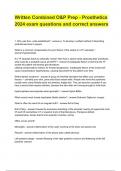
-
Written Combined O&P Prep - Prosthetics 2024 exam questions and correct answers
- Exam (elaborations) • 18 pages • 2024
- Available in package deal
-
- $7.99
- + learn more
Written Combined O&P Prep - Prosthetics 2024 exam questions and correct answ 1. Why was the L-code established? - answer-a. To develop a unified method of describing products/services to payers What is a common compensation for poor flexion of the socket in a TF amputee? - answer-Hyperlordosis If a TF amputee tends to externally "smear" their foot in stance while abducting their prosthesis, what could be a probable cause and WHY? - answer-If inadequate flexion is built into the TF socke...
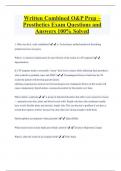
-
Written Combined O&P Prep – Prosthetics Exam Questions and Answers 100% Solved
- Exam (elaborations) • 26 pages • 2024
-
- $12.99
- + learn more
Written Combined O&P Prep – Prosthetics Exam Questions and Answers 100% Solved 1. Why was the L-code established?️️ a. To develop a unified method of describing products/services to payers What is a common compensation for poor flexion of the socket in a TF amputee?️️ Hyperlordosis If a TF amputee tends to externally "smear" their foot in stance while abducting their prosthesis, what could be a probable cause and WHY?️️ If inadequate flexion is built into the TF sock...
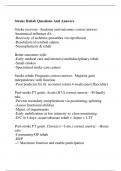
-
Stroke Rehab Questions And Answers
- Exam (elaborations) • 10 pages • 2023
- Available in package deal
-
- $10.49
- + learn more
Stroke recovery: Anatomy and outcomes correct answer: Anatomical influence d/t: -Recovery of ischemic penumbra via reperfusion -Resolution of cerebral edema -Neuroplasticity & rehab Better outcomes with: -Early medical care and intensive multidisciplinary rehab -Small strokes -Specialized stroke care centers Stroke rehab: Prognosis correct answer: Majority gain independence with function -Poor predictor for fn: no motor return 4 weeks post (flaccidity) Post-stroke PT goals:...
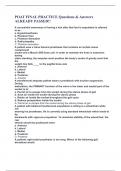
-
POAT FINAL PRACTICE Questions & Answers ALREADY PASSED!!
- Exam (elaborations) • 17 pages • 2024
-
- $15.48
- + learn more
POAT FINAL PRACTICE Questions & Answers ALREADY PASSED!! A non-painful awareness of having a foot after that foot is amputated is referred to as : a. Hyperkinesthesia b. Phantom Pain c. Phantom Sensation d. Radiculopathy C. Phantom sensation A patient uses a trans femoral prosthesis that contains an ischial ramus containment socket and a Mauch SNS knee unit. In order to maintain the knee in extension during static standing, the amputee must position the body's center of gravity such ...
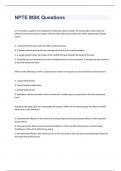
-
NPTE MSK Questions 2023 with 100% correct answers
- Exam (elaborations) • 17 pages • 2023
- Available in package deal
-
- $14.49
- + learn more
A PT examines a patient who complains of foot pain while running. The examination shows that the patient has excessive foot pronation. Which of the following would be the MOST appropriate orthotic insert? A. A lateral forefoot post under the fifth metatarsal head B. A lateral rearfoot post under the calcaneus placing it in an everted position C. A wedge placed under the instep of the medial foot just beneath the head of the talus D. A medial post just proximal to the first metatarsal head ...
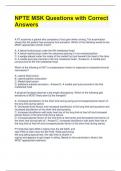
-
NPTE MSK Questions with Correct Answers
- Exam (elaborations) • 11 pages • 2024
- Available in package deal
-
- $13.49
- + learn more
NPTE MSK Questions with Correct Answers A PT examines a patient who complains of foot pain while running. The examination shows that the patient has excessive foot pronation. Which of the following would be the MOST appropriate orthotic insert? A. A lateral forefoot post under the fifth metatarsal head B. A lateral rearfoot post under the calcaneus placing it in an everted position C. A wedge placed under the instep of the medial foot just beneath the head of the talus D. A medial post...

How much did you already spend on Stuvia? Imagine there are plenty more of you out there paying for study notes, but this time YOU are the seller. Ka-ching! Discover all about earning on Stuvia


